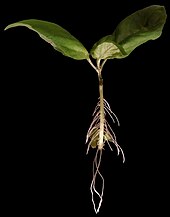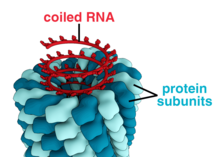|
Organism
An organism is any living thing that functions as an individual.[1] Such a definition raises more problems than it solves, not least because the concept of an individual is also difficult. Many criteria, few of them widely accepted, have been proposed to define what an organism is. Among the most common is that an organism has autonomous reproduction, growth, and metabolism. This would exclude viruses, despite the fact that they evolve like organisms. Other problematic cases include colonial organisms; a colony of eusocial insects is organised adaptively, and has germ-soma specialisation, with some insects reproducing, others not, like cells in an animal's body. The body of a siphonophore, a jelly-like marine animal, is composed of organism-like zooids, but the whole structure looks and functions much like an animal such as a jellyfish, the parts collaborating to provide the functions of the colonial organism. The evolutionary biologists David Queller and Joan Strassmann state that "organismality", the qualities or attributes that define an entity as an organism, has evolved socially as groups of simpler units (from cells upwards) came to cooperate without conflicts. They propose that cooperation should be used as the "defining trait" of an organism. This would treat many types of collaboration, including the fungus/alga partnership of different species in a lichen, or the permanent sexual partnership of an anglerfish, as an organism. EtymologyThe term "organism" (from the Ancient Greek ὀργανισμός, derived from órganon, meaning 'instrument, implement, tool', 'organ of sense', or 'apprehension')[2][3] first appeared in the English language in the 1660s with the now-obsolete meaning of an organic structure or organization.[3] It is related to the verb "organize".[3] In his 1790 Critique of Judgment, Immanuel Kant defined an organism as "both an organized and a self-organizing being".[4][5] Whether criteria exist, or are needed Among the criteria that have been proposed for being an organism are:
Other scientists think that the concept of the organism is inadequate in biology;[13] that the concept of individuality is problematic;[14] and from a philosophical point of view, question whether such a definition is necessary.[15][16][8] Problematic cases include colonial organisms: for instance, a colony of eusocial insects fulfills criteria such as adaptive organisation and germ-soma specialisation.[17] If so, the same argument, or a criterion of high co-operation and low conflict, would include some mutualistic (e.g. lichens) and sexual partnerships (e.g. anglerfish) as organisms.[18] If group selection occurs, then a group could be viewed as a superorganism, optimized by group adaptation.[19] Another view is that attributes like autonomy, genetic homogeneity and genetic uniqueness should be examined separately rather than demanding that an organism should have all of them; if so, there are multiple dimensions to biological individuality, resulting in several types of organism.[20] Organisms at differing levels of biological organisation Differing levels of biological organisation give rise to potentially different understandings of the nature of organisms. A unicellular organism is a microorganism such as a protist, bacterium, or archaean, composed of a single cell, which may contain functional structures called organelles.[22] A multicellular organism such as an animal, plant, fungus, or alga is composed of many cells, often specialised.[22] A colonial organism such as a siphonophore is a being which functions as an individual but is composed of communicating individuals.[8] A superorganism is a colony, such as of ants, consisting of many individuals working together as a single functional or social unit.[23][17] A mutualism is a partnership of two or more species which each provide some of the needs of the other. A lichen consists of fungi and algae or cyanobacteria, with a bacterial microbiome; together, they are able to flourish as a kind of organism, the components having different functions, in habitats such as dry rocks where neither could grow alone.[18][21] The evolutionary biologists David Queller and Joan Strassmann state that "organismality" has evolved socially, as groups of simpler units (from cells upwards) came to cooperate without conflicts. They propose that cooperation should be used as the "defining trait" of an organism.[18]
Samuel Díaz‐Muñoz and colleagues (2016) accept Queller and Strassmann's view that organismality can be measured wholly by degrees of cooperation and of conflict. They state that this situates organisms in evolutionary time, so that organismality is context dependent. They suggest that highly integrated life forms, which are not context dependent, may evolve through context-dependent stages towards complete unification.[24] Boundary casesViruses Viruses are not typically considered to be organisms, because they are incapable of autonomous reproduction, growth, metabolism, or homeostasis. Although viruses have a few enzymes and molecules like those in living organisms, they have no metabolism of their own; they cannot synthesize the organic compounds from which they are formed. In this sense, they are similar to inanimate matter.[7] Viruses have their own genes, and they evolve. Thus, an argument that viruses should be classed as living organisms is their ability to undergo evolution and replicate through self-assembly. However, some scientists argue that viruses neither evolve nor self-reproduce. Instead, viruses are evolved by their host cells, meaning that there was co-evolution of viruses and host cells. If host cells did not exist, viral evolution would be impossible. As for reproduction, viruses rely on hosts' machinery to replicate. The discovery of viruses with genes coding for energy metabolism and protein synthesis fuelled the debate about whether viruses are living organisms, but the genes have a cellular origin. Most likely, they were acquired through horizontal gene transfer from viral hosts.[7]
There is an argument for viewing viruses as cellular organisms. Some researchers perceive viruses not as virions alone, which they believe are just spores of an organism, but as a virocell - an ontologically mature viral organism that has cellular structure.[25] Such virus is a result of infection of a cell and shows all major physiological properties of other organisms: metabolism, growth, and reproduction, therefore, life in its effective presence.[12][26] Organism-like colonies The philosopher Jack A. Wilson examines some boundary cases to demonstrate that the concept of organism is not sharply defined.[8] In his view, sponges, lichens, siphonophores, slime moulds, and eusocial colonies such as those of ants or naked molerats, all lie in the boundary zone between being definite colonies and definite organisms (or superorganisms).[8]
Synthetic organisms Scientists and bio-engineers are experimenting with different types of synthetic organism, from chimaeras composed of cells from two or more species, cyborgs including electromechanical limbs, hybrots containing both electronic and biological elements, and other combinations of systems that have variously evolved and been designed.[27] An evolved organism takes its form by the partially understood mechanisms of evolutionary developmental biology, in which the genome directs an elaborated series of interactions to produce successively more elaborate structures. The existence of chimaeras and hybrids demonstrates that these mechanisms are "intelligently" robust in the face of radically altered circumstances at all levels from molecular to organismal.[27] Synthetic organisms already take diverse forms, and their diversity will increase. What they all have in common is a teleonomic or goal-seeking behaviour that enables them to correct errors of many kinds so as to achieve whatever result they are designed for. Such behaviour is reminiscent of intelligent action by organisms; intelligence is seen as an embodied form of cognition.[27] References
External links
|